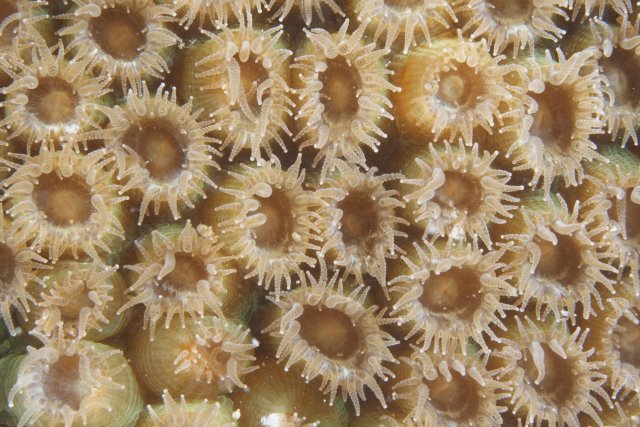J Art for Mexico Made Out of Coral Reef
On this page:
- What are coral reefs?
- Where are coral reefs found?
- Why are coral reefs important?
What are Coral Reefs?
Coral reef ecosystems are intricate and diverse collections of species that collaborate with each other and the concrete environs. Coral is a class of colonial animal that is related to hydroids, jellyfish, and sea anemones.
Stony corals, a type of coral characterized past their difficult skeleton, are the bedrock of the reef. Stony coral colonies are composed of hundreds of thousands of individual living polyps. Polyps are capable of cartoon dissolved calcium from seawater, and solidifying it into a hard mineral (calcium carbonate) structure that serves as their skeletal back up. When you look at a coral colony, just the sparse layer on its surface is live coral; the mass beneath is the calcium carbonate skeleton that may exist decades old.

The irksome growth of polyps and expansion of the hard skeletal structures build up the permanent coral reef construction over fourth dimension.
Polyps of reef-building corals comprise microscopic algae chosen zooxanthellae, which exist with the animal in a symbiotic relationship. The coral polyps (animals) provide the algae (plants) a home, and in commutation the algae provide the polyps with nutrient they generate through photosynthesis. Because photosynthesis requires sunlight, most reef-building corals live in clear, shallow waters that are penetrated by sunlight. The algae also give a coral its colour; coral polyps are really transparent, then the colour of the algae inside the polyps show through.
Coral reefs provide habitat for a large diversity of marine life, including various sponges, oysters, clams, crabs, sea stars, sea urchins, and many species of fish. Coral reefs are also linked ecologically to nearby seagrass, mangrove, and mudflat communities. One of the reasons that coral reefs are then highly valued is because they serve as a heart of activeness for marine life.
Not all corals on the reef are stony corals.
- Hydrocorals , or fire coral, are reef-building hydroids that have a hard calcareous exoskeleton and stinging cells that can cause a called-for sensation when touched.
- Octocorals , or 'soft' corals, include sea fans and sea whips, which grow more like fleshy plants and practise not course calcium carbonate skeletal structures.
- Antipatharians , or black corals, are another type of branching 'soft' coral.
Some soft corals have zooxanthellae to acquire nutrient and free energy, merely others, such as blackness corals, exist without this symbiotic relationship.
Where are Coral Reefs Constitute?
Corals can be found throughout the world's oceans, in both shallow and deep water. Still, the reef-building corals that rely on a symbiotic relationship with algae need shallow, clear water allowing light penetration for photosynthesis. Stony corals also require tropical or sub-tropical temperatures, which be in a band 30 degrees north to thirty degrees due south of the equator.

Coral reefs exist in 7 U.S. states and territories, including:
- Florida,
- Puerto Rico,
- U.South. Virgin Islands,
- Hawaiʻi, and
- Guam, American Samoa, and the Commonwealth of the Northern Mariana Islands.
There are also coral reefs 100 miles offshore of Texas and Louisiana in the Gulf of Mexico, living on the tops of geologic 'mesas'.
Why are Coral Reefs Important?
Coral reefs are among the almost biologically diverse and valuable ecosystems on Earth. An estimated 25 percent of all marine life, including over 4,000 species of fish, are dependent on coral reefs at some point in their life bicycle. Approximately half a billion people globally depend on coral reef ecosystems for food, coastal protection, and income from tourism and fisheries.
Salubrious coral reefs provide:
- Habitat, feeding, spawning, and nursery grounds for over 1 one thousand thousand aquatic species, including commercially harvested fish species.
- Food for people living near coral reefs, especially on small islands.
- Recreation and tourism opportunities, such as fishing, scuba diving, and snorkeling, which contribute billions of dollars to local economies.
- Protection of coastal infrastructure and prevention of loss of life from storms, tsunamis, floods, and erosion.
- Sources of new medicines that can be used to care for diseases and other health problems.
All of the services provided past coral reefs translate into tremendous economic worth. By one estimate, the full net do good per year of the world'southward coral reefs is $29.8 billion. Tourism and recreation account for $ix.vi billion of this amount, coastal protection for $9.0 billion, fisheries for $5.7 billion, and biodiversity, representing the dependence of many dissimilar marine species on the reef structure, for $5.5 billion (Cesar, Burke and Pet-Soede, 2003).
In the U.Due south., the National Marine Fisheries Service estimates the annual commercial value of U.S. fisheries from coral reefs lone to exist over $100 one thousand thousand annually (2001). Reef-based recreational fisheries generate another $100 meg annually in the U.S.
dominguezhime1997.blogspot.com
Source: https://www.epa.gov/coral-reefs/basic-information-about-coral-reefs
Post a Comment for "J Art for Mexico Made Out of Coral Reef"